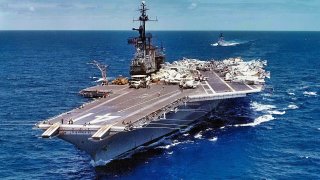Why the Navy's Midway-Class Aircraft Carriers Looked Almost Unstoppable
The Midway-class aircraft carriers, including the USS Midway, USS Franklin D. Roosevelt, and USS Coral Sea, represent the pinnacle of U.S. naval engineering from World War II through the Vietnam War.
Summary and Key Points: The Midway-class aircraft carriers, including the USS Midway, USS Franklin D. Roosevelt, and USS Coral Sea, represent the pinnacle of U.S. naval engineering from World War II through the Vietnam War.

-Influenced by the Royal Navy's wartime experiences, these carriers were designed for durability and firepower. With lengths of 970 feet and displacements over 60,000 tons, they supported large air groups and heavy armament.
-Notably, the USS Coral Sea, commissioned in 1947, played crucial roles in the Mediterranean and Vietnam, earning the nickname "Ageless Warrior." These carriers, the longest-serving of the 20th century, remain icons of American naval prowess.
What Made the Midway-Class So Special
Following the Second World War, the U.S. military recognized how an advanced carrier fleet would serve the country’s defensive and offensive needs. These “floating airports” additionally provided versatility, air support, and power projection. These assets are required by a world power.
The Japanese attack on Pearl Harbor during the war demonstrated just how lethal carrier-based airframes could be, also contributing to the rapid development of new U.S. carriers. The Midway-class aircraft carriers were under development during the war but did not enter service with the Navy until 1945. These impressive vessels have been retired for some time, however, military buffs remain in awe over their legacies. In fact, the Midway-class ships are the longest-serving carriers in the 20th century as they were in service for nearly five decades.
The Origin Story Of The Midway-Class Aircraft Carriers
The resulting design of the Midway-class was heavily influenced by the experience of the Royal Navy’s armored carriers during the war. In the early 1940’s, the HMS Illustrious experienced a devasting blow when three bombs detonated onboard the ship. Following this incident, the Navy incorporated divisions into its hangar space to prevent future fires from spreading throughout the vessel.
The Navy also desired to build a carrier capable of carrying the same number of aircraft as it would in wartime. Around this decade, however, airframes were rapidly increasing in size along with their technological advancements. For this reason, the Navy needed a larger carrier that could support a large air group and deck armor at the same time. The Midway-class ships were notably the last of the U.S. Navy’s designed with a “strength” deck at the hangar deck level and with the armored flight deck as part of the superstructure.
Outlining the Midway-Carrier Class
The three Midway-class carriers were the USS Midway, USS Franklin D. Roosevelt, and the USS Coral Sea. As the last carrier in her series, the Coral Sea did not commission until 1947. She was named to honor the Battle of Coral Sea, which became the first battle in history in which enemy fleets never made visual contact with each other.
During this battle, all kinetic action took place between the opposing fleet’s aircraft. The battle was also an important milestone since a Japanese advance was thwarted. The massive ship measured about 970 feet in length and had a full load displacement of more than 60,000 tons. Four Westinghouse engines powered the carrier, which were fed by a dozen Babcock and Wilcox boilers.
Specs and Capabilities
While the Midway-class carriers were intended to sail faster than the preceding Essex-class ships, their top speed was only even reached by the USS Midway in 1945. Naval Encyclopedia detailed why. “In reality, her sister ships FDR and Coral Sea were modified in between, heavier and as a consequence a bit slower. With the SBC-110/110A upgrade, it fell to 30.6 kts, but after the SCB-101.66 modernization and some optimisations, it reached 31.6 knots again. For comparison, the next Forrestal class, heavier, went for an even larger powerplant, with no less than 8 Steam turbines and new sets of boilers, for 280,000 shp (210,000 kW) and 34 knots, almost unchanged on the 32 kts Kitty Hawks.”
The USS Coral Sea’s Operational History
In 1950, the U.S. military’s AJ-1 Savage heavy attack bomber took off for the first time from a carrier on the Coral Sea. Over the next few years, the carrier would sail to the Mediterranean on service with the Sixth Fleet. When the Coral Sea returned to Norfolk, Virginia for overhaul in 1952, she was re-designated as an attack aircraft carrier. A few years later, the Coral Sea would undergo a secondary refitting, which included a longer angled deck, new steam catapults, and the removal of several anti-aircraft guns and the armor belt.

Perhaps the Coral Sea’s most notable stint was during the Vietnam War. She was the first aircraft carrier to have the Pilot Landing Aid Television system incorporated for operational use, which unquestionably contributed to increased safety protocols onboard. Following the Gulf of Tonkin incident in 1963, the Coral Sea carried out Operation Flaming Dart alongside other U.S. carriers off the coast of North Vietnam. A few years later, the Coral Sea would launch A-6A Intruders and A-7E Corsair II aircraft during Operation Pocket Money against the North Vietnamese.
Nicknamed the “Ageless Warrior” for her years in service, the USS Coral Sea played critical roles in a litany of American operations overseas. While newer and more sophisticated carriers would ultimately replace the aging ship, her honorable sevice legacy will be remembered.
About the Author: Maya Carlin, Defense Expert
Maya Carlin is an analyst with the Center for Security Policy and a former Anna Sobol Levy Fellow at IDC Herzliya in Israel. She has by-lines in many publications, including The National Interest, Jerusalem Post, and Times of Israel. You can follow her on Twitter: @MayaCarlin.
All images are Creative Commons.


